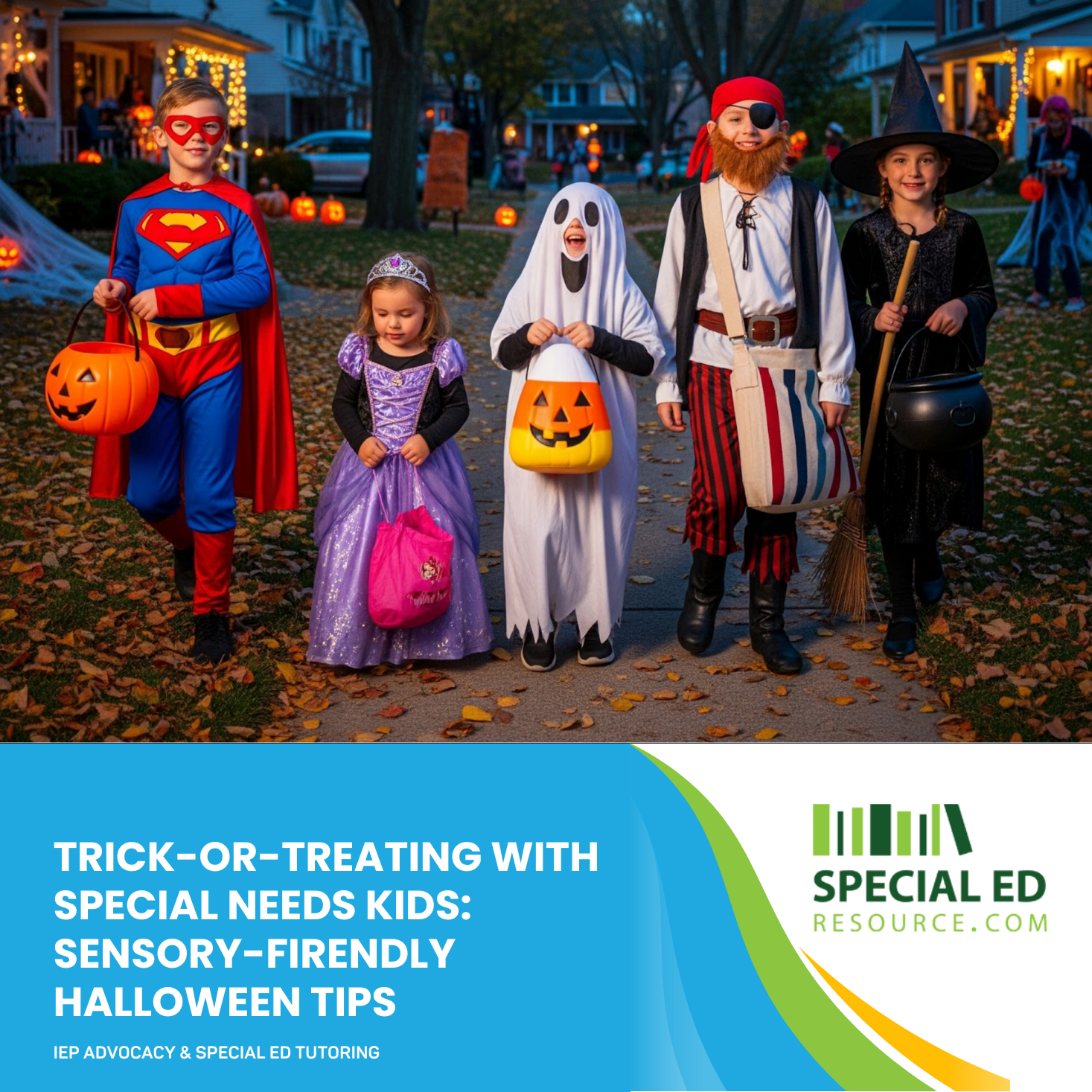A New Way to Celebrate Halloween
For many families, Halloween is filled with laughter, costumes, and neighborhood excitement. But for families of special needs kids — especially those with sensory sensitivities or social anxiety — the same celebration can bring more stress than smiles. Crowded streets, flashing lights, itchy costumes, and loud noises can turn what should be a night of fun into an overwhelming experience.
The good news? A sensory-friendly Halloween is absolutely possible. With a few thoughtful adjustments, families can help their children participate confidently and comfortably in the festivities. Whether that means modifying costumes, choosing calmer routes, or setting clear expectations, it all begins with preparation and understanding.
Families who already work with a special needs tutor or have a child on an Individualized Education Program (IEP) often find that building these routines ahead of time makes social events like Halloween far less intimidating. Predictability and practice are key elements — much like IEP goals — that help children navigate sensory challenges successfully.
Why Halloween Can Be Difficult for Sensory-Sensitive Kids
Halloween is unpredictable by design — new costumes, different environments, bright decorations, and shifting expectations. For children with autism, ADHD, or sensory processing difficulties, that unpredictability can lead to discomfort, anxiety, or emotional overload.
The sensory triggers most families notice include:
- Costumes: Itchy fabrics, tight waistbands, face paint, or masks that make breathing difficult.
- Lighting: Strobe lights, flashing decorations, or dim nighttime streets that can confuse or scare.
- Sounds: Doorbells, shouting trick-or-treaters, or loud Halloween music that startles easily.
- Crowds: Too many people in close proximity, which can make movement or communication hard.
- Routine Changes: Staying up late or skipping familiar activities can increase stress and fatigue.
The key is not to eliminate Halloween, but to modify it for your child’s needs. A sensory-friendly approach helps children experience the same joy as their peers — just in a way that respects their individual comfort level.
Families who prefer a more personalized setting can explore special needs homeschool support or special education tutoring to create structured, manageable celebrations that blend learning, fun, and comfort at home.

Step One: Plan Early and Set Clear Expectations
A sensory-friendly Halloween starts long before October 31. Early planning helps children know what’s coming and what to expect. Predictability gives comfort, and repetition builds confidence — principles that also apply when working toward IEP goals or social skills milestones.
- Talk About What Halloween Is — and Isn’t
Describe what happens during trick-or-treating: walking from house to house, saying “trick or treat,” and receiving candy. Explain how people might dress in costumes and how decorations might look or sound.
- Create a Visual Schedule or Story
Many families use simple picture sequences to show what will happen first, next, and last. These social stories help children rehearse in their mind before the event — just like practicing transitions in special education lessons.
- Do a Practice Walk
A short, low-pressure trial run in daylight can familiarize your child with the route. Point out where houses will hand out candy and where you can take breaks.
- Communicate With Neighbors or Event Organizers
Let them know your family is doing a sensory-friendly approach. Most communities are open to offering non-candy items or keeping lights calm for a few minutes when you arrive.
Planning early ensures that Halloween is no longer a surprise — it becomes a structured, guided experience that builds confidence instead of anxiety.
Step Two: Choose Costumes With Comfort in Mind
Costumes can be a major source of stress for children with sensory sensitivities. Scratchy tags, tight seams, or restrictive accessories can lead to meltdowns before the fun even begins.
To help your child stay comfortable and confident, focus on soft, simple, and familiar:
- Pick breathable fabrics like cotton, fleece, or performance blends instead of stiff polyester.
- Avoid face paint or masks if your child dislikes textures on their skin. Use hats or headbands instead.
- Modify existing clothes — a favorite hoodie can become a dinosaur, astronaut, or superhero with a few creative add-ons.
- Test the costume early. Have your child wear it for short periods at home to check for discomfort.
- Bring backup items like soft gloves, extra socks, or a cozy sweater if the weather or sensations become too much.
Families who incorporate sensory preferences into costumes often notice higher participation and less stress throughout the evening. The costume should help your child feel confident — not confined.
Step Three: Design a Sensory-Friendly Route
Trick-or-treat routes vary widely, but for special needs kids who struggle with sensory overload, the environment makes all the difference. The goal is to control what can be controlled.
Tips for route planning:
- Start early. Go out before the streets fill with crowds. Early daylight hours are calmer and safer.
- Stick to familiar areas. Visit friends, neighbors, or family homes your child already knows.
- Limit the distance. Choose a few welcoming houses rather than a long, unpredictable route.
- Identify safe zones. Plan short breaks — a quiet porch, your car, or a park bench — to reset before continuing.
- Use noise-canceling headphones or ear defenders to reduce background noise without isolating your child.
Even a short, positive trick-or-treat experience can build confidence and independence — skills that align beautifully with IEP social goals.
Step Four: Think Beyond Candy
Traditional candy treats can create challenges — from food allergies to dietary restrictions and choking hazards. Fortunately, inclusive options are easy to find and just as exciting for children.
Consider non-food treats such as:
- Glow sticks, stickers, or bubbles
- Mini puzzles, crayons, or erasers
- Temporary tattoos or fidget toys
- Halloween pencils, rings, or bouncy balls
Participating in the Teal Pumpkin Project, a national campaign promoting non-food treats, signals to families that your home is allergy- and sensory-friendly.
If your child receives candy they cannot eat, create a “trade-in tradition.” Allow them to exchange it later for a small toy, favorite snack, or activity. The focus stays on participation, not restriction.
Step Five: Prepare Emotionally and Practice Coping Strategies
Even with careful planning, unexpected moments can arise — a loud noise, a crowded porch, or an unfamiliar costume. Teaching coping tools helps your child manage those moments calmly.
Try introducing these strategies before Halloween night:
- Practice deep breathing using a fun visual cue, like blowing up an imaginary balloon.
- Develop a code word or signal so your child can quietly indicate when they need a break.
- Rehearse polite responses such as “No thank you” or “Happy Halloween!” to reduce social anxiety.
- Pack a small comfort item like a favorite toy, chewy, or handheld fidget for reassurance.
- Keep communication open — remind your child it’s okay to stop, skip houses, or go home early.
These emotional regulation tools can also reinforce self-management goals from your child’s IEP or tutoring sessions — real-world practice for real growth.
Step Six: Partner With Teachers and Therapists
Halloween experiences often overlap with school activities — classroom parties, costume parades, or themed learning days. Partnering with teachers, occupational therapists, or special education tutors ensures your child’s needs are understood and supported.
Tips for coordination:
- Share your child’s triggers and successful calming techniques ahead of time.
- Ask for clear details about the schedule and expected sensory input (music, costumes, lights).
- Request quiet spaces or alternate participation options if needed.
- Encourage the use of visual schedules or predictable routines in class.
Collaboration between home and school creates consistency and supports IEP goals beyond the classroom. When everyone approaches Halloween with shared understanding, the day becomes more inclusive and less stressful for all students.
Step Seven: Reframe “Success”
Success doesn’t have to mean completing a full night of trick-or-treating or attending every event. For some special needs children, success may look like putting on the costume, visiting one neighbor, or simply watching siblings participate calmly.
Parents can model flexibility by celebrating every small win. Focus on what went well — a smile, a moment of bravery, a calm transition. These experiences teach resilience and reinforce positive associations for next year.
Over time, your child’s comfort level may grow. Each Halloween provides another chance to practice independence, communication, and emotional regulation — skills supported through consistent tutoring or IEP strategies.
Step Eight: Make It a Family Tradition
Sensory-friendly celebrations work best when they become part of family culture. Instead of comparing your experience to others, make it uniquely yours.
Families can:
- Host a quiet Halloween movie night at home with favorite snacks.
- Invite a few close friends for a mini costume parade in the backyard.
- Decorate pumpkins with stickers instead of carving for fine-motor fun.
- Create a “Halloween bucket” filled with toys, art supplies, or sensory-safe treats.
The key is to build joy, not pressure. Inclusive traditions remind children that participation matters more than perfection — a message every child, with or without special needs, deserves to hear.
Empowerment Over Exclusion
Halloween should be about imagination and connection, not anxiety. With thoughtful planning, communication, and compassion, families can make the celebration work for their child’s needs — not the other way around.
Small changes have a big impact. Whether it’s choosing the right costume fabric or adjusting the route to avoid sensory triggers, each choice adds up to a happier, calmer holiday.
And for families seeking extra support, resources like individualized tutoring, special needs homeschool programs, and parent advocacy through Special Education Resource provide practical guidance for turning challenging moments into learning breakthroughs.
Final Thoughts
A sensory-friendly Halloween is more than just a modified event — it’s an inclusive mindset that says every child deserves to join in the fun. By planning ahead, involving your child in the process, and celebrating success on their terms, you’re helping them build confidence, communication skills, and emotional resilience that last far beyond October 31.
Halloween might always come with surprises, but with preparation, understanding, and flexibility, those surprises can turn into the best kind — the kind that bring laughter, pride, and lasting memories for the whole family.





